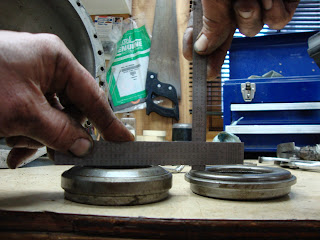From prior run I knew the clutch slipped, but when I removed transmission the disc and pressure plate looked fine, plus were date coded 1979 when the car last had plates. Installed new disc and pressure plate but re-used old release bearing since it's hard to remove plus it also looked brand new. Noticed essentially no movement of the clutch linkage when transmission was re-installed. Thanks to some help from Andy S in checking the linkage movement on his TR3A for comparison, finally diagnosed that the wrong release bearing had been used when the clutch was replaced in 1979, it had been slipping ever since then. I suspect it was a DIY clutch job, and they probably took the transmission in/out several times but were not able to diagnose the problem. See picture for comparison of old and new:
The new one is 5/32 inch shorter (it's a press fit into it's carrier, the surface on the table is what engages the carrier). So, the too thick release bearing was acting like it was pushing down on the clutch pedal all of the time. I installed the new, correct release bearing, put everything back together, and had a very nice ride around the subdivision. Well, except for finding out the hood flies up at 25 mph when you don't tie it down on the front. No damage done, neighbor cutting grass was entertained though. But the clutch engages very smoothly and has no slippage at all.
Friday, December 31, 2010
Wednesday, December 22, 2010
Battery won't fall through now
I painted and installed a new Moss battery box. As you can see in the picture, the old box's floor was completely gone. I had to drill out the spot welds to remove the old box. I also decided not to replace the upper portion of the box, where the body tag resides, that material was fine and would involve a lot more work to replace it. So I cut off both the old box and new box in such a way to give me a 1/4 inch overlap between the two. I also don't have a welder and not sure I want to learn, so I bought some automotive adhesive used to join body panels (Evercoat's Maxim 812, two part, comes in tube for caulking gun with special replaceable nozzle that mixes the two parts). Kind of expensive at $40, but I used about 10% of it for the battery box. Now considering using it to install the floor panels. I am very pleased with how it turned out, had to spend some time making sure the flanges lined up well before gluing it in but the joints sure look solid. I hope I never have to take it back out!
Subscribe to:
Comments (Atom)


